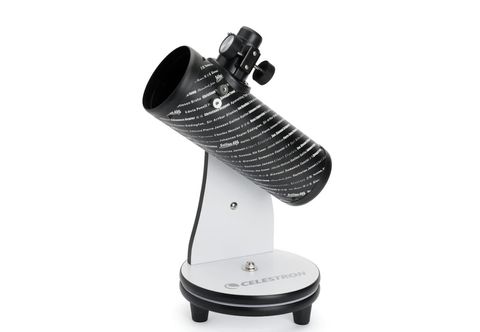Space Verdict
If you're looking for a piece of fuss-free equipment to complement your existing telescope, we recommend buying binoculars of at least 10x50 magnification. However, if you have children who have been bugging you for a telescope and you can't quite commit to a moderately-priced instrument, then the FirstScope may be for you — especially if the lunar surface and casual glances at the night sky are of interest.
Pros
- +
Portable
- +
Easy to use
- +
Robust build
- +
Low investment for casual or young astronomers
- +
Fast focal ratio for easy observations of wide-angle targets
Cons
- -
Loose focuser
- -
Some observations lack clarity and detail
- -
A challenge to collimate
- -
Finderscope not supplied
Why you can trust Space.com
The Celestron FirstScope 76 ticks all of the boxes on a novice skywatcher's wishlist when they're choosing their very first telescope: it exudes portability, ease of use and a price that's not going to break the bank.
What's more, this tabletop telescope is supplied with all of the accessories you need for a fuss-free tour of the night sky, providing improved and more comfortable views of the planets and lunar surface compared to straining the unaided eye or arm fatigue brought about from using binoculars for long periods of time.
Related: Best telescopes: Top picks for beginners, viewing planets, astrophotography and all-arounders
Optical design: Newtonian reflector
Aperture: 2.99" (76 mm)
Focal length: 11.81" (300 mm)
Focal ratio: f/3.95
Eyepiece 1 focal length: 20 mm (15x)
Eyepiece 2 focal length: 4 mm (75x)
Total kit weight: 4.3 lbs. (1.95 kg)
Mount type: Dobsonian
Celestron FirstScope 76: Design
- Already assembled, no tools needed
- Tabletop design perfect for children
- Good quality build for the price
When unpacking the FirstScope, you'll notice that it is already preassembled with only a finder scope needing to be affixed to the telescope tube. The Newtonian reflector is supplied with two eyepieces — 20 mm and 4 mm — and possesses a fast focal ratio to provide a wide field of view that's ideal for not just viewing the planets and the lunar surface, but also allows the observer to view diffuse, wide-angle targets such as star clusters.
Weighing in at a mere 4.3 lbs. (1.95 kilograms), the FirstScope is ideal for those looking for a "grab-and-go" instrument. On close inspection of the overall build, we discovered that the finish isn't perfect with traces of glue apparent on the tube. However, considering what you get for the price, we did note that the telescope's plastics are not glossy and cheap compared to other instruments that fall in a similar price range.
You'll notice that the telescope's base is short, meaning that you'll need to place it on a table in order to use it comfortably: a hindrance for some observers, however, if you have children who have been pestering you for a telescope, the FirstScope is the perfect solution, especially given its small build and ease of use.
With Newtonian designs, the two mirrors within the tube should be aligned and astronomers usually achieve this process — known as collimation — using thumbscrews to adjust the optical system. Unfortunately, these aids are only usually on the more expensive models, meaning that it was quite a task trying to collimate the FirstScope, since the primary mirror isn't adjustable and a collimation cap or eyepiece isn't included with the telescope. Navigation will be tricky too, since a finder scope is not supplied either.
Despite the shortcomings, we couldn't wait to see what the FirstScope was capable of — especially given that we could get started in astronomy with a quick slew of the telescope tube.




Celestron FirstScope 76: First light and functionality
- Provides a "wow factor" for young observers
- Optics struggle to pick out detail
- No finder scope, making star-hopping difficult
- Views are blurred due to loose focuser tube
A clear December sky offered a gaggle of solar system targets including Jupiter, Venus, Saturn and the moon to test the telescope's optical system. Our lunar companion was at 22% illumination, meaning that there wasn't too much natural light pollution to hinder our view of other targets.
With the eyepieces supplied by Celestron, you won't get hugely close-up views of the surface of the moon, but you'll be able to see craters and get a feel for the rugged terrain along the terminator (the point where night meets day). The optics do not provide pin-sharp sights through the field of view since the focuser tube is quite loose, but even such basic observations are sure to delight those who have always wanted to get a closer look at the lunar surface without straining their eyes.
The second planet from the sun, Venus, made for an easy target in the southwest, shining at a stunning magnitude of -4.9. Visible as a bright white "star" to the unaided eye, we hoped for good views through the FirstScope — but, as suspected, we didn't see a great deal of detail with glare making it difficult to distinguish a phase. Saturn was small, faint and fuzzy in the field of view, yet it was possible to make out the gas giant's rings and yellow coloration.
The FirstScope's wide-angle views did provide fair sights of the Pleiades (Messier 45), in the constellation of Taurus. Each of the young, hot member stars in this open cluster sat neatly and clearly in the field of view with some minor adjustments of the focuser.
Navigating without a finder scope did prove quite cumbersome during our observations, making star-hopping especially difficult. The FirstScope needs to be equipped with a light finder scope but given that the least overbearing optical finder scopes fail to pick up stars with magnitudes below naked-eye visibility, we recommend using a red dot finder — especially in light-polluted areas.
Waiting until dawn was worthwhile as Jupiter, which shone at -1.9, rose in the southeast. While it was difficult to spot any details on the gas giant, such as its belts and Great Red Spot without the use of a filter, the Galilean moons — Io, Ganymede, Europa and Callisto — appeared as bright points of light either side of its equator. While the FirstScope's offerings aren't as impressive as those achieved through a dedicated 'scope, they are sure to provide a "wow factor" for first-time and young observers.
Celestron FirstScope 76: Verdict
The FirstScope 76 promotes fuss-free observing but provides views that will disappoint astronomers looking for an additional piece of kit to supplement their hobby. Better suited as a beginner telescope, this Newtonian reflector is a worthwhile low-budget purchase for children — especially if you suspect that astronomy is likely to be a passing phase or basic but fair views of the moon, planets and stars are suitable before investing in an upgrade.
For the price, the FirstScope 76 is supplied with a basic build that's suitable to begin casual tours of the night sky. However, if you are looking to make the most of its optical system while improving navigation, we recommend introducing a red dot finder, investing in a set of eyepieces that are respectful of the telescope's highest useful magnification of 180x and filters that will improve the contrast of solar system targets.
Join our Space Forums to keep talking space on the latest missions, night sky and more! And if you have a news tip, correction or comment, let us know at: community@space.com.

Gemma currently works for the European Space Agency on content, communications and outreach, and was formerly the content director of Space.com, Live Science, science and space magazines How It Works and All About Space, history magazines All About History and History of War as well as Science, Technology, Engineering, Arts and Mathematics (STEAM) kids education brand Future Genius. She is the author of several books including "Quantum Physics in Minutes", "Haynes Owners’ Workshop Manual to the Large Hadron Collider" and "Haynes Owners’ Workshop Manual to the Milky Way". She holds a degree in physical sciences, a Master’s in astrophysics and a PhD in computational astrophysics. She was elected as a fellow of the Royal Astronomical Society in 2011. Previously, she worked for Nature's journal, Scientific Reports, and created scientific industry reports for the Institute of Physics and the British Antarctic Survey. She has covered stories and features for publications such as Physics World, Astronomy Now and Astrobiology Magazine.
